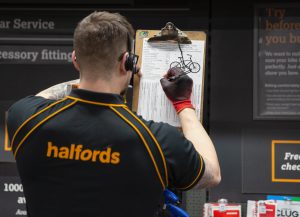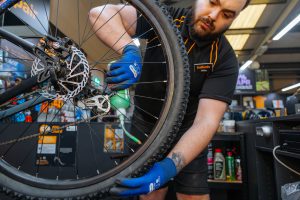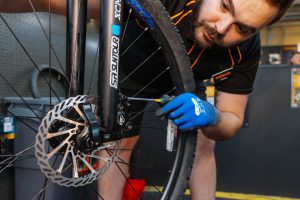Understanding and maintaining essential bike components
Understanding all the separate parts of a bike can be confusing for beginner cyclists, but familiarising yourself with them is important. Knowing how each different bike component works is crucial to recognising any faults or damage that could hinder your cycling performance.
After each bike ride, especially if it was through wet and muddy conditions, clean your bike to prevent a build-up of grime that may interfere with its normal functions. To make it easier, we’ve broken down the main components that form your bike’s parts and given some tips on how to maintain them to maximise their performance and longevity.
Shop bike maintenance today with Halfords.

The bike frame
Types of bike frames
Your bike’s frame is an integral element and acts as the structural skeleton that connects all of the other bike parts. Most commonly, bike frames follow the ‘diamond’ type, consisting of two sections -the main triangle and the rear triangle. However, there is also a type known as a ‘step-through frame’ featuring a lowered top tube bar for easier and more accessible mounting. Step-through frames are a popular choice among older or novice cyclists and young children. Additionally, they’re great for commuters as they make wearing long skirts easier by preventing them from getting caught in the frame.
Bike frames are designed to bear the load of your cycling journeys, whether that’s the weight of the rider or the forces created by pedalling and braking. That’s why they come in a variety of different materials so that there’s plenty of choice to support different cyclists.
- Steel – a robust and forgiving frame, steel is easy to repair but generally heavier to transport. A steel frame bike is a great choice for casual cyclists as it’s durable and great at absorbing blows on rough terrain.
- Alloy – a lightweight option, alloy frames are known for being affordable and are ideal for commuters. Alloy bikes perform best when ridden on smooth surfaces such as concrete, as they offer little vibration damping.
- Carbon – carbon frames balance being the ultralight option without sacrificing vibration control. They offer a rigid performance but are more delicate and vulnerable to hidden damage. They’re also more expensive than steel and alloy frames.
Achieving the perfect ride starts with understanding your bike, whether that’s its specific design, materials, intended use or sizing. Knowing how to measure a bike frame is easy with our bike frame size guide.
So, now you’ve selected the correct frame for your cycling ambitions, it’s vital you understand how to support and maintain it.
Maintaining your bike frame
Regardless of your specific frame type, it’s important to keep it in top condition to ensure both safety and longevity. The last thing any cyclist wants is to ride around on a rusty bike! Depending on how frequently you use your bike, you should clean the frame fairly often (every month or two) to remove the dirt that will damage your paint and potentially attract corrosion. This is also a good opportunity to inspect the bike frame for any cracks or misalignment.
Without your bike frame, you simply wouldn’t be able to cycle! Understanding how to pick the right bike frame for you, plus how to service it, is critical for extending its lifespan.
Wheels and tyres
What makes up your bike’s wheels?
Your bike’s wheels and tyres support your journey by turning your pedalling motion into smooth and safe manoeuvres. They bear the weight of both the rider and bike, allowing movement by rolling. We’ve broken the main bike wheel parts down so that you can more easily identify any faults:
- Hub – the central component of the wheel that holds it all together, the hub houses the bearings and axle.
- Spokes – these thin rods link the hub to the wheel rim to ensure structural integrity. The more spokes a wheel has, the stronger it’s likely to be. For a bit of fun (and added safety), many cyclists add spoke lights to their bikes so that they’re more noticeable during hours of low light. If your spokes aren’t properly tensioned, the wheel can feel wobbly, and the overall handling performance will decline.
- Rim – the outer band of the wheel, your bike’s rim supports the entire tyre. Rim-brake bikes feature a braking surface on the rim, where the brake pads press down and create friction to slow the bike.
- Tyre – the tyre is the only part of the bike wheel that contacts the ground. Constructed from rubber, bike tyres come in different formats, including tubeless, clincher, and tubular. Your bike tyres need to be correctly inflated, otherwise you’re more likely to experience the dreaded flat tyre!
Maintaining your wheels
When it comes to finding your perfect fit, measuring bike wheel size is an essential step that allows your bike to support you and keep the journey comfortable. However, keeping your bike’s wheels and tyres in good condition is vital for getting the most out of their lifespan.
At Halfords, we offer a puncture prevention service for bikes, meaning that you can say goodbye to flat tyres. Using a high-quality, non-toxic slime sealant, your bike is protected for 2 years from tread area punctures sized 3mm or less. But if it’s too late for preventative measures, you can fix your tyre’s puncture effortlessly with our range of patch kits.
It’s also essential that you keep an eye on your bike’s tyre pressure. Typically, bikes designed for off-roading will have lower pressure tyres as they provide better traction while road bikes utilise higher pressures to achieve greater speeds. Regardless, underinflated bike tyres will create issues like increased rolling resistance and an overall decline in performance.

Steering
What makes up your steering?
The bike components involved in steering your bicycle can be broken down into simple parts.
- Handlebars – the bars that you hold onto with your hands, applying pressure to move the front wheel in a certain direction.
- Bike stem – transmits turning input from the handlebars down to the fork’s steerer tube.
- Fork – the front part of the bike that holds the front wheel, rotates so that the wheel turns and transfers load from the road into the frame.
- Headset – a critical bike component for safe control, the headset uses bearings which allow the fork and handlebars to rotate smoothly for steering without friction or looseness.
Maintaining your bike’s steering system
Maintaining the parts that control your bike’s steering is essential for safety and performance. Perform visual checks regularly, examining the front of your bike for any obvious looseness, cracks or rust. You should check that your stem bolts are snug and that there’s no stiffness in your headset when turning. If there is, you may need to adjust the headset. You may wish to lubricate the headset bearings and expose bolt threads, keeping grit away while protecting the overall steering performance.
Drivetrain
The collection of parts responsible for turning the effort of pedalling into a smooth and speedy forward motion is called the drivetrain.
What makes up your drivetrain?
- Crank set – here, you attach your pedals and your physical efforts are converted into rotational movement, driving the chain.
- Bottom bracket – the bearings and axle assembly that the crank set turns on, the bottom bracket allows for the smooth rotation of the crank set and helps to limit friction.
- Chain – the loop of metal links that connect the front chainrings to the cassette (rear gears), the chain transmits power and moves to turn the rear wheel.
- Cassette – the stack of cogs at the rear wheel hub that provides different gears. Cyclists shift their gears down when going uphill to allow for easier pedalling and do the opposite when riding downhill or fast on flat terrain.
- Derailleurs – these devices guide the chain onto different chainrings or cassette cogs as you shift gears due to changes in terrain or gradient.
- Shifters – located on the handlebars, these levers/buttons are controlled by the cyclist’s fingers, allowing them to shift gears by sending force to the derailleurs.
Cleaning and preserving your drivetrain
Sufficient lubrication and general cleanliness allows your drivetrain to work more efficiently for less effort. Friction and grime increase resistance, meaning that the cyclist must pedal harder for the same speed. Plus, bike parts can get expensive, so looking out for them reduces the number of times that you’ll have to pay to replace them.
After every ride, especially if you’re cycling through muddy conditions, give your bike and drivetrain a wipe down and listen out for any signs that your chain is noisy. It’s also a good idea to lube your chain lightly – never do this while the parts are wet and don’t over lubricate as this attracts rust and dirt. Keep an eye on general wear and tear as bike parts, including the chain and cassette, will need to be replaced once the wear threshold is exceeded to prevent damage to the other parts.

Brakes
Arguably, the most important part of the bike is the brakes. Without satisfactory bike brakes, your journey is compromised and very unsafe. Even if you’re riding on flat terrain, there’s always the chance a sudden hazard will emerge. and you’ll need to stop in an emergency. If your brakes are worn or warped, you’ll experience weaker braking power and may crash or lose control of your bike.
Types of bike brakes
There are two main types of bike brakes: rim brakes and disc brakes. Rim brakes feature brake pads that squeeze the wheel rim when you pull the lever – you slow down using friction. However, disc brakes, whether cable-activated and mechanical or hydraulic (fluid), work via a rotor attached to the wheel hub. When the cyclist brakes, the pads in a calliper squeeze the rotor and slow the wheel. For this reason, disc brakes are generally more powerful.
Components of your bike’s braking system
Although not present in every brake system, the typical components involved in braking are as follows:
- Brake lever – located on the handlebars, the cyclist squeezes to initiate braking, and this force puts the rest of the brake system in motion.
- Brake cable – constructed from strong steel, the brake cable connects the brake lever to the calliper.
- Calliper – the part around the wheel that holds the brake pads and force mechanisms. The calliper must be properly positioned and aligned for effective braking.
- Brake pads – these friction surfaces press against the rotor or rim to stop your bike, although they wear down over time, negatively impacting stopping power.
If your vehicle is suffering from squeaky bike brakes, it might be time to give them a thorough clean. You can use brake cleaner on the surfaces, but avoid getting lubrication on the pads, rotor and rim. It’s also an essential step to check your brake pads, as if they’re too worn, you’ll need to replace them.
Pedals
Types of bike pedals
You may have heard about a few different types of bike pedals, but there are two that are most commonly used. The platform pedal is just a simple, flat pedal without any parts to catch your foot in. They’re simple to use and great for casual riders – just remember your foot is more likely to slip in wet conditions. The other type is called clipless or clip-in pedals; you clip into them via a cleat on your specialised shoes. Clipless pedals are typically more efficient, especially for longer rides, but it can be tricky to get out of them quickly, if you’re a beginner rider.
Identifying the parts that make up the pedals
To properly maintain your bike pedals and ensure smooth cycling, you’ll need to know how to identify the pedal parts.
- Spindle/Axel – the central shaft that threads into the crank arm and allows for pedal rotation. Your threads will need to be well-greased, or they may seize up or the pedal may become wobbly.
- Bearings – found inside the pedal, the bearings also contribute to smooth rotation. If the bearings fail, you’ll feel increased friction when pedalling. Take care to protect bearings from water and dirt.
- Pedal platform – the main surface where your foot rests. This outer shell can be made from different materials including plastic, aluminium, or steel.
Found only on clipless pedals, the cleat mechanism works using springs and tension. If it becomes worn down, the release can become unpredictable and dangerous. Likewise, on platform pedals, metal pins or raised surfaces are often used to increase the grip between your shoe and the pedal. If the pins become worn down, they can typically be replaced with spares.
Cleaning your pedals
You should always make sure to wipe down and clean your pedals, feeling for any grinding or looseness. Every couple of months you can check your pedal bearings ensuring that they feel smooth rather than gritty. If you smell burnt grease or hear squeaking that doesn’t improve after being cleaned or lubricated, your pedal may have damaged internal parts.
If a replacement is required, our helpful guide can inform you on how to remove bike pedals efficiently. Check out our bike pedals buyer’s guide for more help on picking out your new set.
Saddle
Types of bike saddles
Bike saddles come in a variety of types as they’re designed for multiple purposes and riding styles. They come designed with different types of shells (plastic, fibreglass, carbon), padding (foam, gel, a combination) and covers (vinyl, leather, synthetic leather). Saddles also differ due to additional features such as suspension, cut-outs, and flutes, all offering different levels of support and comfort.
If you’re a casual or leisure rider, a wider saddle is likely to be most suitable as it supports sitting in an upright position. However, for long-distance road or mountain bikers, narrower and longer performance saddles are ideal as they help to prevent chaffing.
Protect your bike saddle from wet weather and moisture, or treat yourself to additional cushioning with our helpful range of saddle covers. They’ll protect your saddle when you’re out and about, particularly relevant for those made using leather. Plus, using one saves you from cycling home with a soggy saddle!
Caring for your bike saddle
After you ride, ensure that your saddle is clean, dry and that it’s not tilting in a certain direction. If you do feel movement or notice a difference in position, the seatpost clamp may need tightening.
Cleaning and caring for your bike will lead to results. You’ll spend far less on unnecessary replacements and repairs and maximise the lifespan of your bike. Taking the necessary steps to keep your bike and bike parts in good condition will also help to improve your cycling performance and enhance rider safety. Remember that regular maintenance is far more effective than big but sporadic scrub-ups!
Why not pick up a bike stand (alongside the essential bike maintenance tools) so you can easily carry out all DIY bike repairs in the ideal position, without damaging your handlebars!
At Halfords, we offer a range of bike services ideal for both regular maintenance and emergency repairs. Our silver interim service is the most popular, offering a 15-part inspection; our experts will examine all your bike’s components and replace wearable parts, including your inner brake and gear cables. We also offer a free 25-point bike check, so you can have your bike’s health assessed, and any potential points for repair will be identified.


